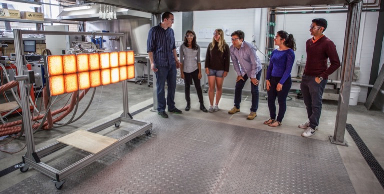Burn, burn, burn ...
Mentor:
- Cristian Maluk
Project Team:
- Mindy Tresize
- John Nguyen
- Bronte Nagy-Cox
Project Brief

Traditional fire laboratories use a wide range of heating apparatus and equipment for heating and burning test samples; for example, the standard cone calorimeter or the fire propagation apparatus. This project intends for students to engage in the design and construction of a set of novel heating apparatus to be implemented in UQ’s fire lab.
Within the scope of this project students will design and construct new experimental setups having the opportunity to:
- Work in the fire laboratory;
- Investigate some of the fundamentals of fire safety science;
- Design novel mechanical and/or electrical apparatus.
It is intended that this project will result in the creation of a new set of novel that will form part of future experimental research studies in civil and fire safety engineering.
Project Report
Over Semester 1, three Icarus students undertook the project ‘Burn, Burn, Burn’ to gain insight into Fire Engineering and become acquainted with the Fire Laboratory. The aim of the project was to construct a heating apparatus to be added to the testing devices in the laboratory. The difference between this apparatus and current tools in the laboratory is that this small scale device is made of radiant panels that are programmed to move- creating a heat flux. By testing materials against a heat flux rather than heating at a constant rate allows the observer to identify if the material will behave differently if exposed to different way of heating.
Upon commencing this investigation our team had the opportunity to extend our knowledge of Fire Engineering by helping Daan, a student completing his Masters, analyse the effect of different sprinkler flow rates on controlling the growth of a fire in a car. Some skills we gathered were learning how to operate thermocouples, use a blowtorch and how to organise a project efficiently to maximise the quantity of tests performed. The experience proved intangible benefits as our team could learn fire theory by observing them in practice, and by being surrounded in the expertise of Dr. Cristian Mulak and other senior members of the fire team we quickly learnt some basics.
There were many hurdles in the construction of the heating apparatus. Learning how to use the mass flow meter, design the set-up of the natural gas pipeline and designing a base for all components to be attached to were the three main elements of our project. Over Semester 1 the apparatuf was constructed, however we will continue into Semester 2 to make the device mechanical to create the flux and also to test the instrument to ensure accuracy for future use.

